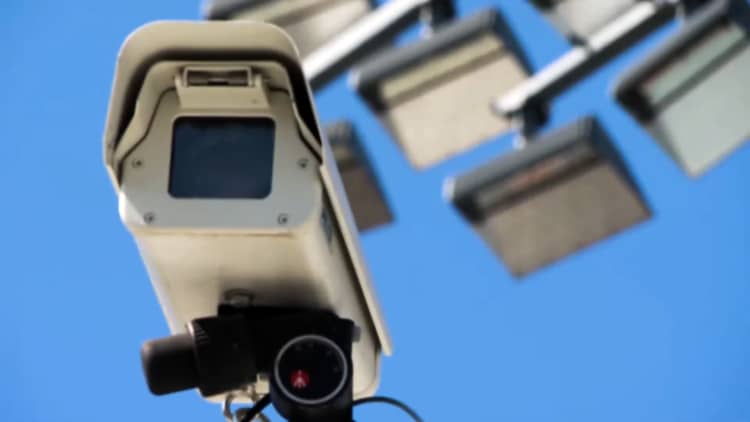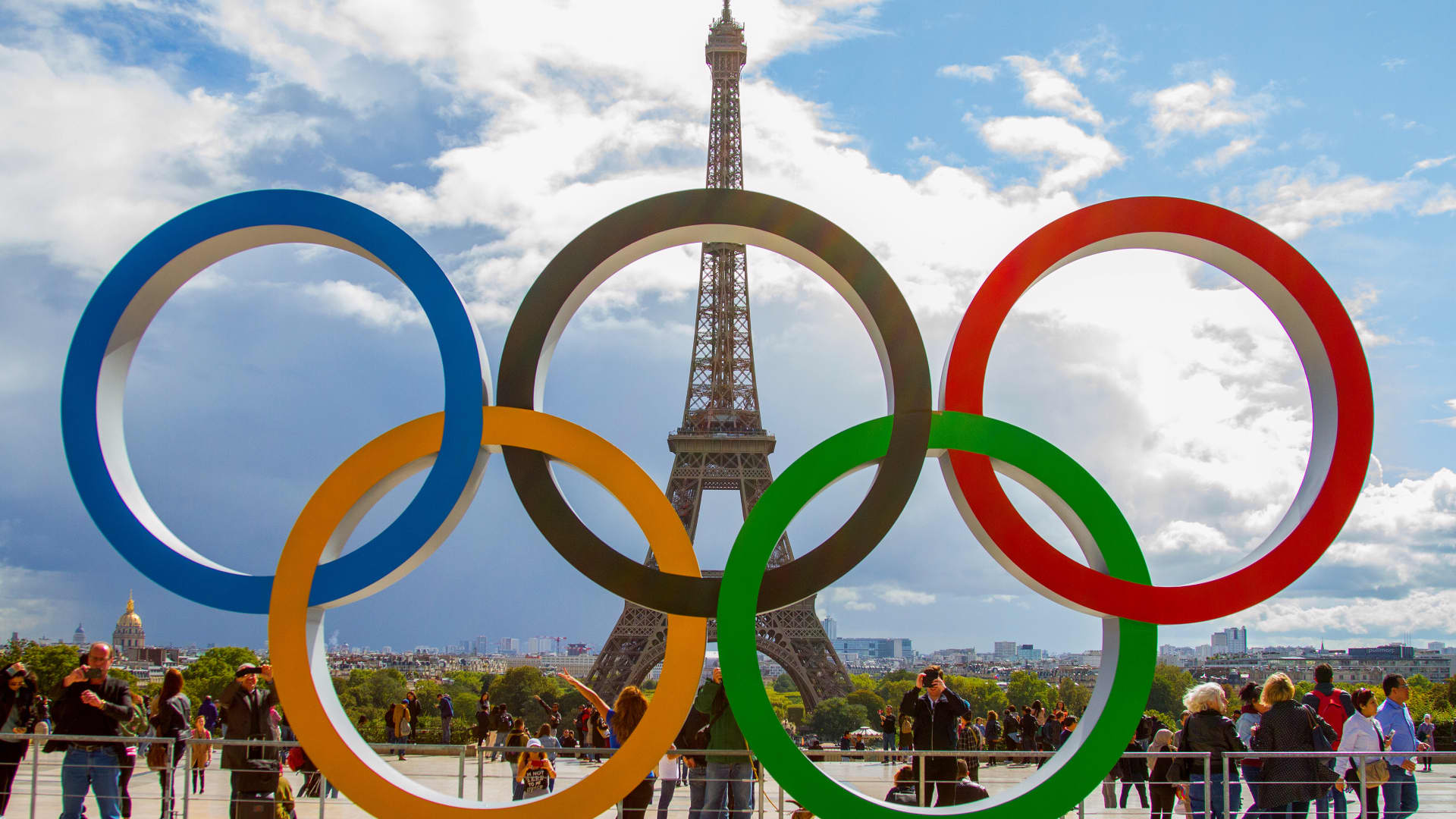PARIS, ILE DE FRANCE, FRANCE – 2017/09/14: The Olympic Rings being placed in front of the Eiffel Tower in celebration of the French capital won the hosting right for the 2024 summer Olympic Games. (Photo by Nicolas Briquet/SOPA Images/LightRocket via Getty Images)
Sopa Images | Lightrocket | Getty Images
Training of elite athletes dates as far back as the Ancient Olympic Games, when so-called gymnastes advised runners, chariot racers, wrestlers and boxers on technique, nutrition and strength conditioning.
Fast forward to today’s Olympians prepping for next summer’s Paris Games. Their trainers and coaches adhere to the same Olympic motto — faster, higher, stronger — yet have the added benefit of millennia of ever-advancing technology, which now has been super-charged with artificial intelligence.
Trainers and coaches at U.S. Soccer, one of the 47 National Governing Bodies overseen by the United States Olympic and Paralympic Committee, are using AI technology to instantaneously identify and track player movements and ball positions. A suite of software tools allows them to study a variety of human performance metrics, such as body position, velocity, speed and timing in real time on the field of play.
“Utilizing advances in AI and computer vision, we’ve been able to track and study personalized analytics from a variety of sports to determine the strengths and deficiencies in an athlete’s movement and help them make data-informed training and competition plans that can help them improve their performance, as well as their own health,” said Mike Levine, director of performance innovation business operations at the USOPC, based in Colorado Springs, also the home of a high-tech Olympic training center.
While the USOPC and NGBs employ in-house experts in bleeding-edge technology development, data analytics and sports sciences and medicine, big tech companies lend their AI know-how as well. USA Surfing staff, for instance, has teamed up with Microsoft engineers to figure out how best to ride waves. They take digital videos of surfers in action and use AI to analyze data on body movement, surfboards and waves to determine what they did well and what could be improved.
“This work saves coaches and staff hundreds of hours of video tagging, facilitates the accumulation of more and higher-quality data and affords analysts and coaches significantly more time to analyze the data and implement learnings into real-life training and performance,” Levine said.
Creating 3-D models of athletes’ bodies with Intel technology
These are manifestations of computer vision systems, which use AI technology to replicate the capabilities of the human brain responsible for object recognition and classification. A commercial application, called 3D Athlete Tracking (3DAT), was developed by Intel‘s Olympic Technology Group a few years ago and is now being utilized by trainers in numerous sports. 3DAT incorporates sensor-less motion capture and digital video to create three-dimensional models of an athlete’s entire body, from head to toes, which trainers use to tweak and improve performance.
“We’re able to see ways athletes move and detect things not possible with just the human eye,” said Jonathan Lee, who as senior director of sports technology at Intel helped develop 3DAT and is now chief product officer at London-based sports tech company ai.io, which recently acquired the system from Intel.
3DAT has been adopted by Exos, a coaching company in Scottsdale, Arizona, that trains college football players for the National Football League’s annual scouting combine, an evaluation ahead of the league’s yearly draft. “Exos uses 3DAT to analyze the 40-yard dash and help players get faster,” Lee said. Digital video cameras, mounted on timing gates incrementally positioned along the course, capture data on how a runner comes off the line, his acceleration and velocity, and his body’s angle of attack.
The data instantaneously constructs a personalized skeletal model of each player for immediate review. Before a player’s next sprint, a trainer might say, “You need to be more upright or lean forward, and give him tips on how to achieve that,” Lee said.
The NFL-Amazon digital player and concussion-risk tracking
The NFL itself is harnessing AI and computer vision to enhance its Digital Athlete program, developed in partnership with Amazon Web Services beginning in 2019. The Digital Athlete provides a complete view of each NFL players’ experience by analyzing data from his training and game activity, which is captured by sensors and tags in equipment and hours of video from cameras in stadiums. Computer vision and machine learning systems track speed, collisions, blocks and tackles. This data is shared with clubs and allows teams to precisely understand what players need to stay healthy, recover quickly and perform at their best.
“AI and machine learning are the backbone of the program,” said Jennifer Langton, NFL senior vice president of health and safety innovation. “We’re able to analyze a substantial amount of data and automatically generate insights into which players might benefit from altering either training or recovery routines, a process that used to be so manual and cumbersome.”
The AI was taught to identify trauma by repeated exposure to and digestion of digital video images of helmets from all angles, Langton said, and then to cross-reference visual information from statistical data to determine what player was wearing what helmet. “With enough practice, the AI becomes exponentially faster and more reliable than humans at accurately identifying and classifying head collisions throughout a game and the season,” she said, allowing trainers and coaches to see which players are due to reduce their workloads and which have room for a more intensive workout.
The Digital Athlete program was rolled out as a pilot with four NFL teams last year and this season is available to all 32 franchises via a dedicated online portal. “The portal provides teams with a daily training load and risk-mitigation information, as well as league-wide injury trends and benchmarks they hadn’t had before,” Langton said, adding that the NFL will assess the data at the end of the season to evaluate tangible results of the program.
‘The next big thing’: Twin hearts of elite athletes
Another AI-enabled technology that’s making its way into elite athlete training is the digital twin, a virtual replica of a physical object, process or system that can be used to simulate, predict and improve real-world scenarios. Tata Consultancy Services, headquartered in Mumbai, recently announced a partnership with French tech developer Dassault Systèmes to produce a digital twin heart, mimicking the flesh-and-blood one of Des Linden, a two-time Olympic marathoner and winner of the 2018 Boston Marathon (sponsored by TCS, along with the races in New York, Chicago and London).
Des Linden makes her way to the finish line during the 127th Boston Marathon in Boston, Massachusetts on April 17, 2023.
Joseph Prezioso | Afp | Getty Images
Linden’s avatar organ — created using AI-analyzed data from CT scans and MRIs — can simulate her heart rate, blood flow and oxygen levels, providing instant feedback that can be interpreted to adjust her training and competition. “We want to understand what is a safe zone for Des’ trainer to put her through,” said Dr. Srinivasan Jayaraman, a principal scientist at TCS. Instead of having her run on a treadmill or outdoors, “We can run simulations using her digital twin heart to vary different cardiovascular parameters and fine-tune her training.”
Linden is no stranger to sports tech, from online message boards back in her high school days for remotely comparing times with other runners to today’s state-of-the-art running shoes that world-class marathoners have broken records wearing. “The digital twin heart is going to be the next big thing,” she said. “Being able to map out [my training] and see the gains and drawbacks ahead of time will allow me to work smarter, not harder.”
That’s what Linden, aided by her digital twin heart, will be doing to train for the 2024 Olympic marathon trials in February. Qualifying for her third Team USA slot “will be a tough task,” said the 40-year-old runner, “but I’ll take a crack at it.”
AI and sports training diets
Although there’s no news yet of a digital twin of the human digestive system, AI is involved in planning Olympic athletes’ diet and nutrition. Alicia Glass, a senior sports dietician for the USOPC, designs meal plans for about 300 athletes with USA Track and Field and USA Swimming, a labor-intensive, hand-written task that’s been simplified with an AI-powered app called Notemeal. “They collected data from 37 dieticians from professional sports teams and organizations and used those data sets to generate individualized meal plans,” she said. “The value-add is that it’s a network of sports dieticians working with the best of the best athletes in the world.”
Glass still relies on her professional skills to understand the events each athlete competes in, their training regimens and goals, as well as their genetics, lean body mass and metabolic rate. Even athletes who train and compete in the same events require totally individualized meal plans, she said. “Notemeal makes that process a lot easier,” she said.
The athletes access Notemeal with a smartphone app. “I hit a toggle on my phone, and they get a text saying a meal has been created for you,” Glass said, adding that the app also applies AI to design personalized shopping lists and recipes.
Glass won’t claim that high-tech dietary planning will win medals next summer in Paris, but “many athletes would admit it helps improve their lifestyle because they’re more aware” of their personal fueling needs.
Linden says there is no turning back from the increasing role of technology in the lives of elite athletes. “Let’s just personalize the heck out of training and make sure we’re getting the maximum gains without setbacks from overworking,” she said.


